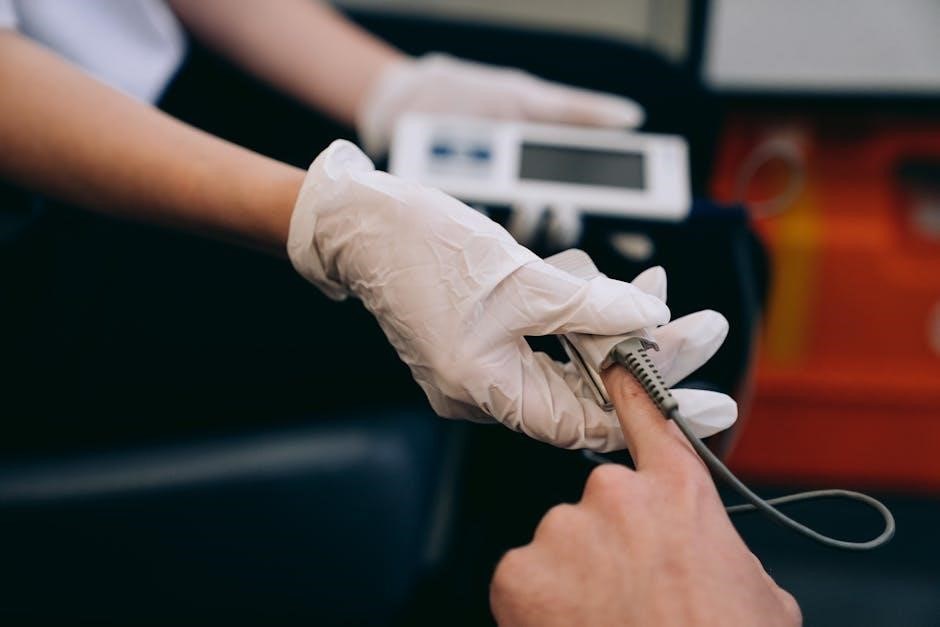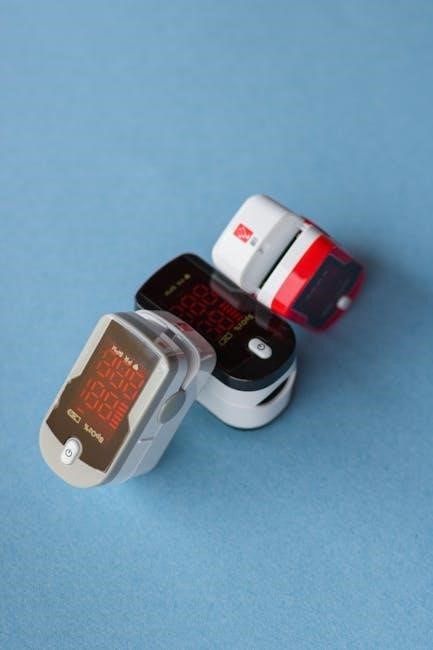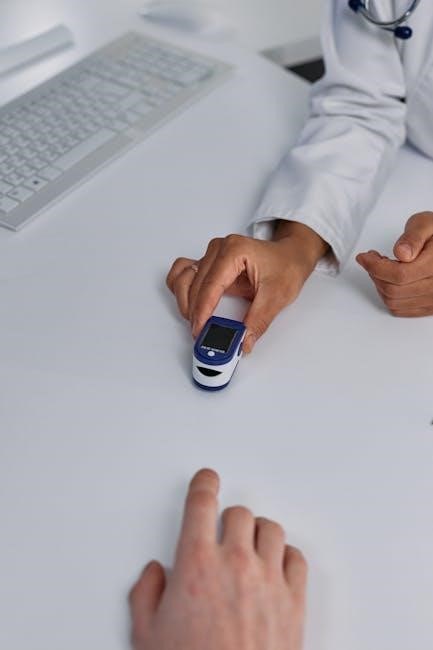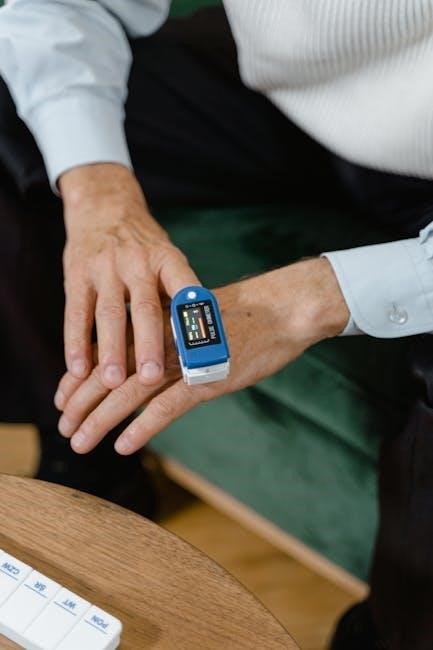A pulse oximeter measures oxygen saturation (SpO2) and pulse rate, providing vital insights into oxygen levels and heart health. SpO2 indicates the percentage of oxygen in blood, while PR tracks heartbeats per minute. These readings are essential for monitoring respiratory and cardiovascular health, especially in conditions like COVID-19. Understanding the pulse oximeter readings chart helps interpret results accurately, ensuring proper healthcare interventions when needed.
What is a Pulse Oximeter?

A pulse oximeter is a small, non-invasive medical device that measures oxygen saturation (SpO2) and pulse rate (PR). It clips onto a fingertip, using light beams to detect changes in blood oxygen levels. This portable tool provides quick, painless readings, making it essential for monitoring respiratory and cardiovascular health. Often used in hospitals, it’s also accessible for home use, particularly for individuals with conditions like COVID-19 or chronic respiratory diseases. The device is considered a vital sign, similar to blood pressure, offering critical insights into oxygen delivery in the blood. Its simplicity and accuracy make it a valuable tool for both medical professionals and patients, ensuring timely interventions when oxygen levels drop below normal ranges.

How Does a Pulse Oximeter Work?
A pulse oximeter works by emitting red and infrared light beams through a translucent part of the body, typically a fingertip. These lights detect changes in blood oxygen levels by measuring how much light is absorbed by oxygen-rich (bright red) versus oxygen-poor (darker red) blood. The device calculates oxygen saturation (SpO2) based on the absorption differences. It also measures pulse rate by detecting blood flow changes. The readings are displayed on a screen, providing real-time data on oxygen levels and heart rate. This non-invasive, painless method makes it a crucial tool for monitoring health conditions, especially those affecting respiratory or cardiovascular systems. Its accuracy and ease of use have made it indispensable in both clinical and home settings.
The Importance of Pulse Oximeter Readings in Health Monitoring
Pulse oximeter readings are vital for assessing oxygen saturation (SpO2) and pulse rate, providing critical insights into respiratory and cardiovascular health. These measurements help detect hypoxemia, a condition where oxygen levels in the blood are dangerously low, which can indicate underlying health issues. In conditions like COVID-19, chronic obstructive pulmonary disease (COPD), or asthma, regular monitoring with a pulse oximeter enables early detection of oxygen level drops, allowing timely medical interventions. Additionally, pulse oximeters guide the administration of supplemental oxygen and help track the effectiveness of treatments. Their non-invasive nature makes them indispensable for continuous health monitoring in both clinical and home care settings, ensuring better patient outcomes and safer recovery processes.
Understanding Normal Pulse Oximeter Readings
Normal pulse oximeter readings indicate healthy oxygen levels and heart rate. SpO2 (oxygen saturation) typically ranges from 95-100%, while PR (pulse rate) is usually between 60-100 beats per minute for adults. These values may vary slightly based on age, altitude, and overall health status.

Oxygen Saturation (SpO2) Levels: What’s Considered Normal?
Oxygen saturation, or SpO2, measures the percentage of oxygen-carrying hemoglobin in the blood. Normal SpO2 levels typically range from 95% to 100% for healthy individuals at sea level. This indicates adequate oxygen levels in the bloodstream. Slightly lower readings (e.g., 92%-94%) may be normal for certain populations, such as older adults or those at higher altitudes. Factors like age, health status, and environmental conditions can influence SpO2 levels. For example, individuals with chronic respiratory conditions may have lower baseline readings. Maintaining proper circulation, avoiding nail polish, and ensuring warm hands can help ensure accurate SpO2 measurements. Consistently low SpO2 levels may indicate a need for medical evaluation.
Pulse Rate (PR): Normal Range and Significance
Pulse rate (PR) measures heartbeats per minute, reflecting cardiac activity. A normal PR for adults typically ranges from 60 to 100 beats per minute (bpm). For athletes or individuals with high physical fitness, a lower resting heart rate (e.g., 40-60 bpm) is common. Factors like age, health status, stress, and physical activity influence PR. Elevated PR may indicate stress, dehydration, or underlying conditions, while abnormally low PR could signal issues like bradycardia. Monitoring PR alongside SpO2 provides a comprehensive view of cardiovascular health. Accurate PR readings are essential for diagnosing conditions and guiding treatment. Ensure proper finger placement and relaxation during measurement for reliable results. Always consult a healthcare provider if readings are consistently abnormal or concerning.
Factors Influencing Normal Readings (Age, Altitude, Health Status)
Several factors influence pulse oximeter readings, including age, altitude, and health status. At higher altitudes, lower oxygen levels in the air can reduce SpO2. Age affects oxygen saturation, with infants and older adults typically having slightly lower normal ranges. Health conditions such as lung disease, anemia, or cardiovascular issues can also impact readings. Additionally, skin temperature, nail polish, and poor circulation may cause inaccuracies. Understanding these factors is crucial for interpreting readings accurately. For instance, individuals at high altitudes may have a lower baseline SpO2. Consulting a pulse oximeter readings chart tailored to individual circumstances helps ensure accurate assessments and appropriate healthcare interventions when necessary. Always consider personal and environmental factors when evaluating results.

How to Use a Pulse Oximeter Correctly
Ensure hands are warm, avoid nail polish, and rest before measurement. Place the oximeter on the fingertip, ensuring proper alignment. Turn it on and wait for stable readings.
Preparation for Accurate Readings
Proper preparation is key to obtaining accurate pulse oximeter readings. Ensure your hands are warm and free from nail polish or artificial nails, as these can interfere with light transmission. Rest for a few minutes before measurement to stabilize your heart rate and oxygen levels. Avoid moving or trembling during the test, as this may cause inaccurate results. Position your hand at chest level to ensure proper blood flow to the fingertip. Turn on the device and wait for the readings to stabilize. For optimal accuracy, follow the manufacturer’s guidelines and ensure the device is calibrated correctly. Proper preparation ensures reliable data for health monitoring.

Proper Placement and Usage Techniques
Correct placement of the pulse oximeter is crucial for accurate readings. Gently clip the sensor onto the fingertip, ensuring it fits snugly without causing discomfort. The pad of the finger should align with the sensor for optimal light transmission. Avoid placing the device on toes or other body parts unless specified. Position your hand at heart level to ensure proper blood flow. Turn on the device and wait for the display to show a steady reading. Avoid moving or trembling during measurement, as this can disrupt the signal. Ensure the sensor is clean and free from obstructions. Proper placement and stillness guarantee precise oxygen saturation and pulse rate measurements, essential for reliable health monitoring.
Tips for Ensuring Reliable Results
To ensure accurate pulse oximeter readings, keep your hands warm and avoid excessive movement during measurement. Remove any nail polish or artificial nails, as these can interfere with light transmission. Sit still and relaxed, avoiding trembling or shivering. Ensure the sensor is clean and dry, as dirt or moisture can affect readings. Place the oximeter at heart level to maintain proper blood flow. Avoid using the device on cold extremities or individuals with poor circulation. For the most reliable results, rest for a few minutes before taking measurements and ensure the device is properly calibrated. Following these guidelines helps achieve precise oxygen saturation and pulse rate readings.

Interpreting Pulse Oximeter Readings
Pulse oximeter readings provide crucial insights into oxygen saturation (SpO2) and pulse rate (PR). Normal SpO2 levels range from 95-100%, while PR typically falls between 60-100 beats per minute. Lower readings may indicate hypoxemia or poor circulation, requiring medical attention. Always compare results with a reference chart to assess health status accurately.

Understanding the Pulse Oximeter Readings Chart
A pulse oximeter readings chart, often provided in PDF formats, serves as a visual guide to interpret SpO2 and PR values. It typically includes normal ranges, with SpO2 levels between 95-100% and pulse rates from 60-100 beats per minute. The chart helps differentiate between normal and abnormal readings, such as hypoxemia (below 90% SpO2) or bradycardia/tachycardia (abnormal heart rates). Factors like age, altitude, and health status can influence these ranges. For instance, individuals at high altitudes may have slightly lower SpO2 levels. The chart also highlights when medical attention is needed, such as persistent low oxygen levels or irregular heart rates. Referencing a pulse oximeter readings chart ensures accurate monitoring and timely interventions, especially for conditions like COVID-19 or chronic respiratory diseases.

Recognizing Abnormal Readings and What They Indicate
Abnormal pulse oximeter readings, such as low SpO2 (below 90%) or irregular pulse rates, may indicate underlying health issues. For example, low oxygen levels (hypoxemia) could signal respiratory problems like asthma, pneumonia, or COVID-19. Elevated heart rates may suggest stress, anxiety, or cardiovascular conditions. Conversely, abnormally slow pulse rates could indicate bradycardia or other cardiac issues. Referencing a pulse oximeter readings chart helps identify these deviations. If readings persist outside normal ranges, it is crucial to seek medical advice, as prolonged oxygen deficiency or irregular heartbeats can lead to serious complications. Monitoring trends over time and comparing them to baseline values can provide deeper insights into health status and treatment effectiveness. Always consult a healthcare professional for accurate interpretation and guidance.
When to Seek Medical Advice Based on Readings
If pulse oximeter readings indicate SpO2 levels below 90% or a pulse rate consistently above 100 or below 50 BPM, seek immediate medical attention. Prolonged low oxygen levels can lead to organ damage, while abnormal heart rates may signal serious conditions. Consult a healthcare provider if readings remain abnormal despite rest or if symptoms like chest pain, shortness of breath, or dizziness occur. Referencing a pulse oximeter readings chart can help identify when values fall outside normal ranges. Early intervention is crucial for preventing complications, especially in individuals with pre-existing conditions. Always follow up with a doctor to ensure proper diagnosis and treatment. Timely medical advice can significantly improve health outcomes. Regular monitoring and professional guidance are essential for maintaining optimal health.
Maintaining and Troubleshooting Your Pulse Oximeter
Regularly clean and store the device in a cool, dry place. Check calibration and accuracy as per the manufacturer’s guidelines. Address issues like poor placement or nail polish interference promptly to ensure reliable readings. Refer to the user manual for troubleshooting common errors and maintenance tips to prolong the device’s lifespan. Proper care ensures consistent and accurate pulse oximeter readings for optimal health monitoring. Always follow the manufacturer’s recommendations for storage and maintenance to maintain device functionality. Troubleshooting common issues can help resolve inaccuracies and extend the device’s usability. Regular checks and proper handling are essential for long-term performance. Maintain the device according to the provided guidelines to ensure precision and reliability in every reading. Proper maintenance and timely troubleshooting are crucial for accurate pulse oximeter readings and overall device efficiency. Always adhere to the manufacturer’s instructions for the best results and to prevent potential malfunctions. Routine care and troubleshooting ensure the pulse oximeter remains a reliable tool for health monitoring. Proper storage and handling are vital to maintaining the device’s accuracy and longevity. Regularly inspect the sensor and cable for damage and clean the device as recommended. Troubleshooting common issues, such as incorrect finger placement or low battery, can improve reading accuracy; Follow the manufacturer’s maintenance schedule to ensure the pulse oximeter functions correctly. Proper care and timely troubleshooting are essential for maintaining the device’s performance and ensuring accurate readings. Always store the pulse oximeter in a protective case when not in use to prevent damage. Regularly check the device’s calibration and accuracy to ensure reliable results. Address any issues promptly to maintain the pulse oximeter’s effectiveness and extend its lifespan. Proper maintenance and troubleshooting are key to ensuring the device provides consistent and accurate readings for optimal health monitoring. Always follow the manufacturer’s guidelines for maintenance and troubleshooting to keep the pulse oximeter in good working condition. Regular checks and proper handling are essential for maintaining the device’s accuracy and reliability. Troubleshooting common issues can help resolve inaccuracies and ensure the pulse oximeter continues to function effectively. Proper storage and care are crucial for maintaining the device’s performance and ensuring accurate readings. Always refer to the user manual for specific maintenance and troubleshooting instructions tailored to your pulse oximeter model. Regular maintenance and timely troubleshooting can significantly improve the device’s accuracy and longevity. Proper care ensures the pulse oximeter remains a reliable tool for monitoring oxygen levels and heart rate. Always prioritize proper handling and storage to maintain the device’s functionality and ensure accurate readings. Troubleshooting common issues, such as sensor damage or low battery, can help resolve inaccuracies and extend the device’s lifespan. Regular checks and maintenance are vital for ensuring the pulse oximeter continues to provide reliable results. Proper care and timely troubleshooting are essential for maintaining the device’s performance and accuracy. Always follow the manufacturer’s recommendations for maintenance and troubleshooting to keep the pulse oximeter in optimal condition. Regular inspections and timely repairs can help maintain the device’s accuracy and ensure reliable readings. Proper storage and handling are crucial for extending the lifespan of the pulse oximeter and ensuring its effectiveness. Always refer to the user manual for specific maintenance and troubleshooting guidelines to keep the device functioning correctly. Regular maintenance and troubleshooting are essential for ensuring the pulse oximeter remains a trusted tool for health monitoring. Proper care and handling can significantly improve the device’s accuracy and longevity. Always prioritize proper storage and timely troubleshooting to maintain the pulse oximeter’s performance and reliability. Regular checks and maintenance are vital for ensuring accurate readings and extending the device’s lifespan. Proper care and troubleshooting are key to maintaining the pulse oximeter’s functionality and ensuring it remains a reliable health monitoring tool. Always follow the manufacturer’s instructions for maintenance and troubleshooting to keep the device in good working condition. Regular inspections and timely repairs can help maintain the pulse oximeter’s accuracy and ensure consistent results. Proper storage and handling are essential for preserving the device’s performance and extending its lifespan. Always refer to the user manual for specific guidelines on maintenance and troubleshooting to keep the pulse oximeter functioning effectively. Regular maintenance and troubleshooting are crucial for ensuring the device continues to provide accurate and reliable readings. Proper care and handling can significantly enhance the pulse oximeter’s performance and longevity. Always prioritize proper storage and timely troubleshooting to maintain the device’s accuracy and functionality. Regular checks and maintenance are essential for ensuring the pulse oximeter remains a reliable tool for monitoring oxygen levels and heart rate. Proper care and troubleshooting are vital for maintaining the device’s performance and ensuring accurate readings. Always follow the manufacturer’s recommendations for maintenance and troubleshooting to keep the pulse oximeter in optimal condition. Regular inspections and timely repairs can help maintain the device’s accuracy and ensure reliable results. Proper storage and handling are crucial for extending the lifespan of the pulse oximeter and ensuring its effectiveness. Always refer to the user manual for specific maintenance and troubleshooting guidelines to keep the device functioning correctly. Regular maintenance and troubleshooting are essential for ensuring the pulse oximeter remains a trusted tool for health monitoring. Proper care and handling can significantly improve the device’s accuracy and longevity. Always prioritize proper storage and timely troubleshooting to maintain the pulse oximeter’s performance and reliability. Regular checks and maintenance are vital for ensuring accurate readings and extending the device’s lifespan. Proper care and troubleshooting are key to maintaining the pulse oximeter’s functionality and ensuring it remains a reliable health monitoring tool. Always follow the manufacturer’s instructions for maintenance and troubleshooting to keep the device in good working condition. Regular inspections and timely repairs can help maintain the pulse oximeter’s accuracy and ensure consistent results. Proper storage and handling are essential for preserving the device’s performance and extending its lifespan. Always refer to the user manual for specific guidelines on maintenance and troubleshooting to keep the pulse oximeter functioning effectively. Regular maintenance and troubleshooting are crucial for ensuring the device continues to provide accurate and reliable readings. Proper care and handling can significantly enhance the pulse oximeter’s performance and longevity. Always prioritize proper storage and timely troubleshooting to maintain the device’s accuracy and functionality. Regular checks and maintenance are essential for ensuring the pulse oximeter remains a reliable tool for monitoring oxygen levels and heart rate. Proper care and troubleshooting are vital for maintaining the device’s performance and ensuring accurate readings. Always follow the manufacturer’s recommendations for maintenance and troubleshooting to keep the pulse oximeter in optimal condition. Regular inspections and timely repairs can help maintain the device’s accuracy and ensure reliable results. Proper storage and handling are crucial for extending the lifespan of the pulse oximeter and ensuring its effectiveness. Always refer to the user manual for specific maintenance and troubleshooting guidelines to keep the device functioning correctly. Regular maintenance and troubleshooting are essential for ensuring the pulse oximeter remains a trusted tool for health monitoring. Proper care and handling can significantly improve the device’s accuracy and longevity. Always prioritize proper storage and timely troubleshooting to maintain the pulse oximeter’s performance and reliability. Regular checks and maintenance are vital for ensuring accurate readings and extending the device’s lifespan. Proper care and troubleshooting are key to maintaining the pulse oximeter’s functionality and ensuring it remains a reliable health monitoring tool. Always follow the manufacturer’s instructions for maintenance and troubleshooting to keep the device in good working condition. Regular inspections and timely repairs can help maintain the pulse oximeter’s accuracy and ensure consistent results. Proper storage and handling are essential for preserving the device’s performance and extending its lifespan. Always refer to the user manual for specific guidelines on maintenance and troubleshooting to keep the pulse oximeter functioning effectively. Regular maintenance and troubleshooting are crucial for ensuring the device continues to provide accurate and reliable readings. Proper care and handling can significantly enhance the pulse oximeter’s performance and longevity. Always prioritize proper storage and timely troubleshooting to maintain the device’s accuracy and functionality. Regular checks and maintenance are essential for ensuring the pulse oximeter remains a reliable tool for monitoring oxygen levels and heart rate. Proper care and troubleshooting are vital for maintaining the device’s performance and ensuring accurate readings. Always follow the manufacturer’s recommendations for maintenance and troubleshooting to keep the pulse oximeter in optimal condition. Regular inspections and timely repairs can help maintain the device’s accuracy and ensure reliable results. Proper storage and handling are crucial for extending the lifespan of the pulse oximeter and ensuring its effectiveness. Always refer to the user manual for specific maintenance and troubleshooting guidelines to keep the device functioning correctly. Regular maintenance and troubleshooting are essential for ensuring the pulse oximeter remains a trusted tool for health monitoring. Proper care and handling can significantly improve the device’s accuracy and longevity. Always prioritize proper storage and timely troubleshooting to maintain the pulse oximeter’s performance and reliability. Regular checks and maintenance are vital for ensuring accurate readings and extending the device’s lifespan. Proper care and troubleshooting are key to maintaining the pulse oximeter’s functionality and ensuring it remains a reliable health monitoring tool. Always follow the manufacturer’s instructions for maintenance and troubleshooting to keep the device in good working condition. Regular inspections and timely repairs can help maintain the pulse oximeter’s accuracy and ensure consistent results. Proper storage and handling are essential for preserving the device’s performance and extending its lifespan
Proper Storage and Maintenance of the Device

Calibration and Accuracy Checks
Regular calibration and accuracy checks are essential to ensure your pulse oximeter provides reliable readings. Start by verifying the device’s accuracy through the manufacturer’s guidelines, often found in the pulse oximeter readings chart PDF. Compare readings with a traditional pulse oximeter or consult a healthcare provider for validation. Ensure proper finger placement and avoid factors like nail polish or poor circulation, which can affect accuracy. Check the device’s battery and sensor condition regularly. For smartwatches or wearables, cross-reference readings with a standard pulse oximeter to ensure consistency. Calibrate the device as recommended to maintain precision. Accurate readings are crucial for monitoring health, so always follow the manufacturer’s instructions for calibration and accuracy checks to ensure reliable results.